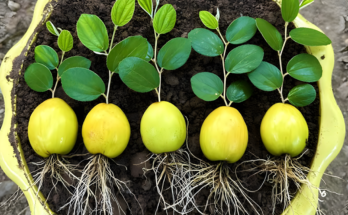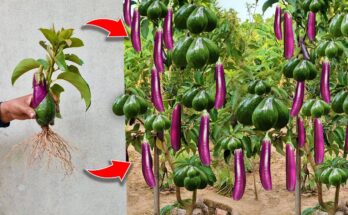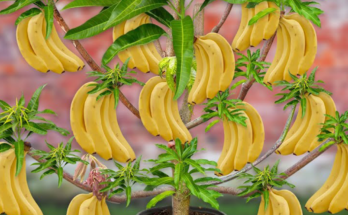Easy and Fast Method to Propagate and Grow Breadfruit Trees
Breadfruit (Artocarpus altilis) is one of the most valuable tropical fruit trees, cherished not only for its delicious starchy fruits but also for its ability to provide food security, shade, and even timber. Known as a “tree of life” in many island cultures, breadfruit can thrive in tropical climates and provide food for decades once established. However, many gardeners and farmers are often discouraged by the misconception that breadfruit is slow or difficult to propagate. In reality, with the right techniques, there are easy and fast methods to propagate and grow breadfruit trees successfully. This article explains practical methods that anyone can use, whether for home gardens or larger agricultural projects.
Why Breadfruit Is Worth Growing
Before diving into the propagation methods, it’s helpful to understand why breadfruit is so special:
- Nutritional value: Breadfruit is rich in complex carbohydrates, dietary fiber, vitamins, and minerals. It can be baked, boiled, fried, or processed into flour.
- Sustainability: Once established, breadfruit trees can produce fruit for more than 50 years with minimal input.
- Environmental benefits: Breadfruit trees provide shade, prevent soil erosion, and improve soil fertility when intercropped with other plants.
- Income potential: The fruit, flour, and even value-added products such as chips or baked goods are in high demand.
With so many benefits, learning an efficient method to propagate and grow breadfruit can be life-changing for farming families and communities.
Propagation Methods for Breadfruit
Breadfruit can be propagated in several ways, but the easiest and fastest techniques involve root cuttings, air layering, and tissue culture. Let’s focus on the most practical methods for farmers and home gardeners.
1. Propagation by Root Cuttings
This is one of the most reliable and simple ways to propagate breadfruit.
Steps:
- Select a healthy parent tree that is 3–5 years old and producing strong root suckers.
- Expose roots about 2–5 cm thick by carefully digging near the base of the tree.
- Cut 20–30 cm sections of the root. Each piece should be healthy, firm, and free of disease.
- Plant the root cuttings horizontally in a nursery bed or pots, burying them about 5–10 cm deep. Keep the soil moist but not waterlogged.
- Provide partial shade to protect young shoots as they emerge.
In 4–8 weeks, shoots will develop from the cuttings, and within 3–4 months, the young plants will be ready for transplanting into the field.
2. Propagation by Air Layering
Air layering is a traditional method that gives faster results compared to growing from seeds (which are rarely used for breadfruit because many varieties are seedless).
Steps:
- Select a healthy branch about 1–2 cm thick.
- Make a small cut or remove a ring of bark around the branch.
- Wrap the exposed area with moist coconut fiber, sphagnum moss, or soil, then cover it with plastic to retain moisture.
- Keep the moss moist by occasionally opening and re-wetting it.
- After 6–8 weeks, roots will form at the cut site.
- Cut off the branch below the rooted section and plant it in a nursery pot for establishment.
This method allows farmers to produce clones of high-yielding breadfruit varieties.
3. Tissue Culture (Advanced Method)
Although more technical, tissue culture is the fastest method for large-scale propagation. It involves growing small plant parts in sterile laboratory conditions to produce uniform seedlings. Many agricultural research centers use this method to distribute disease-free planting materials. Farmers can purchase tissue-culture seedlings if available.
Growing Breadfruit Trees Successfully
After propagating your seedlings, the next step is to establish them in the field or garden. Here are key tips:
1. Choosing the Right Location
- Breadfruit grows best in tropical to subtropical climates with abundant rainfall.
- It prefers well-drained, fertile soil but can tolerate sandy or rocky soils once established.
- Select a sunny area with enough space—breadfruit trees can grow up to 20 meters tall and need room to spread their canopy.
2. Planting the Seedlings
- Transplant when seedlings are 30–50 cm tall.
- Dig holes about 60 cm wide and 60 cm deep, and mix topsoil with compost or organic manure.
- Plant one seedling per hole, and water thoroughly after planting.
- Maintain a spacing of 8–10 meters between trees to allow healthy growth.
3. Care and Maintenance
- Watering: Young trees need regular watering, especially during dry seasons. Mature trees are drought tolerant.
- Mulching: Apply organic mulch such as dry leaves, grass, or coconut husks to conserve soil moisture and suppress weeds.
- Fertilization: Use organic compost or a balanced NPK fertilizer during the first 2–3 years to boost growth.
- Weeding: Keep the base weed-free to reduce competition for nutrients.
- Pruning: Light pruning helps shape the tree and prevent overcrowding.
4. Pest and Disease Management
Breadfruit is relatively hardy, but watch out for common pests like scale insects, mealybugs, and fruit flies. Use natural pest control methods such as neem oil sprays or biological predators. Ensuring good airflow around trees reduces fungal infections.
Harvesting Breadfruit
Depending on the propagation method and growing conditions, breadfruit trees begin producing in 3–5 years. Each mature tree can yield 50–200 fruits per year, depending on variety and care. The fruits are harvested when mature but still firm, as they ripen quickly after picking.
Conclusion
Propagating and growing breadfruit trees doesn’t have to be slow or complicated. With easy and fast methods like root cuttings and air layering, farmers and gardeners can quickly produce healthy seedlings and establish productive trees. Once planted, breadfruit trees provide food, income, and ecological benefits for decades with relatively little maintenance. For anyone living in the tropics, learning this propagation skill is a step toward greater self-sufficiency and food security.
The breadfruit tree truly lives up to its reputation as a “tree of life”—and with these simple methods, anyone can grow it with success.



